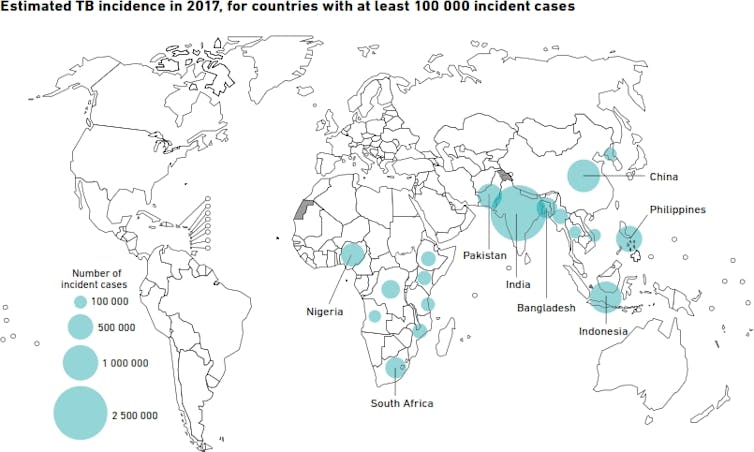How Would You Know if You Ave Tb in Other Parts of Tyour Body
The world marks World Tuberculosis (TB) Mean solar day on March 24 every twelvemonth. Most people assume that TB only affects the lungs – but the disease can besides attack other organs. The Conversation Africa'due south Ina Skosana spoke to Professor Nazir Ismail to find out more than. Professor Ismail works and conducts his research in Due south Africa, ane of the globe's TB hot spots.
What parts of the torso does TB touch on?
TB near normally affects the lungs – what'southward known as the body's pulmonary system. But it affects other organs too, what'south known as extrapulmonary TB.
Other organs that can be affected include the lining covering the lungs (pleural TB); the fundamental nervous system (TB meningitis); bone and joints (musculoskeletal arrangement); lymph nodes; abdomen – where the liver, spleen and the intestines can be affected (abdominal TB); kidney and bladder (urogenital TB); and claret.

A study conducted in Johannesburg showed that the most common sites of extra pulmonary TB were the pleura (39.i%), lymph nodes (31.0%), blood (21.viii%), central nervous system (7.3%), and abdomen (2.nine%).
Another study conducted in the KwaZulu-Natal province as well showed pleural TB to be the well-nigh mutual form of extra pulmonary TB (36% of patients).
How common is this form of TB? What causes it?
Co-ordinate to the World Health Organisation's well-nigh recent TB written report, extrapulmonary TB accounted for 14% of TB cases recorded globally in 2017. Across the African continent, extrapulmonary TB accounted for 16% of the 1 323 450 cases recorded. In South Africa it accounts for 11% of all TB cases reported.
Chiefly – dissimilar pulmonary TB, which is spread through the air from person to person – extrapulmonary TB is not infectious.
A fundamental risk factor for developing extrapulmonary TB is a compromised immune system which is why it is more mutual in patients infected with HIV. It can likewise occur in people with diabetes, cancer, depression trunk weight and chronic kidney illness. Smoking and the use of drugs that can suppress the immune system also increase the hazard of extrapulmonary TB.
Though the gamble factors differ, all types of TB develop in the aforementioned way. TB infection occurs when a person inhales droplet particles containing the TB bacterium. Once inhaled, the bacteria then heads for the lungs. If the immune system is fully functional, several mechanisms are put in place by the body'due south response to the foreign agent to incorporate the leaner. The end outcome is unremarkably a walled off "granuloma", preventing the TB bacteria from multiplying and making the person sick.
In some patients, the TB escapes to another part of the body earlier the lungs can wall it off. In healthy people with strong immune systems, other organs or systems volition put upwards a "bulwark" that's similar to the lung's granuloma.
Merely if this defence mechanism fails, the leaner multiply and cause disease in that specific organ organisation. This is called chief TB and is unremarkably seen in young children.
Sometimes, a person can successfully wall off TB when they are healthy. Only equally their immune system weakens – because of onetime age, or conditions like HIV and diabetes – the wall can pause down. If that happens, the bacteria tin can multiply and lead to agile disease.
How is extrapulmonary TB diagnosed and treated?
Clinicians find it challenging to diagnose extrapulmonary TB. This is considering the patient doesn't present with the typical signs and symptoms of pulmonary TB – chronic cough, fever, loss of weight and night sweats. In some cases, the presenting signs and symptoms tin exist very vague and can mimic other weather. All this means the clinician must have a strong suspicion that their patient has extrapulmonary TB to even start seeking this diagnosis.
Investigations include Ten-rays, CT scans or MRIs and sending appropriate specimens to the laboratory to find the TB bacterium. The blazon of specimen that should exist sent depends on the organ system involved. For example, in the case of lymph node TB, a biopsy (tissue specimen) of the lymph node should be sent to the laboratory; in the case of pleural TB, pleural fluid should exist sent for testing.
It is important to note that in certain instances, fifty-fifty though the laboratory result might be negative, the clinician may still opt to treat for tuberculosis based on the loftier clinical suspicion, constellation of clinical signs and symptoms; and adjunct special investigations (biopsy, CT scans).
The drugs used to treat extrapulmonary TB are the same as those used for the treatment of pulmonary TB. The just divergence is that the elapsing of treatment for extrapulmonary TB is longer and depends on the organ system involved. Most extrapulmonary TB is treated for nine months only can sometimes be longer. Handling is taken orally and is a combination tablet that is dosed based on a person's weight. Infirmary admission is not required for treatment unless the patient is severely ill. Patients can proceed to have their medication at home.
How does a person know they've got it?
The presentation of extrapulmonary TB depends on which organ is involved. An example is lymph node TB on a person's neck which would present equally a noticeable growth or lump. In that location are multiple causes for such a growth, 1 of which is TB, which the md would know to investigate. Thus seeking medical advice early on when you are unwell is an important starting point.
Source: https://theconversation.com/tb-doesnt-only-attack-the-lungs-other-organs-are-also-vulnerable-113791
0 Response to "How Would You Know if You Ave Tb in Other Parts of Tyour Body"
Post a Comment